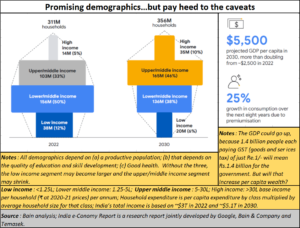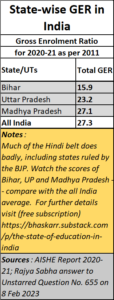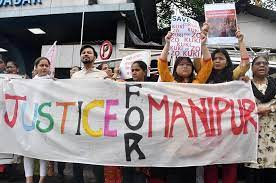Governance: hype, hope, and hell
RN Bhaskar
There is confusion that has gripped many Indians about the fate of the country’s polity and its future.
On the one hand there are eulogies about the enormous potential India holds out.
 On the other are indicators that cause much anxiety.
On the other are indicators that cause much anxiety.
Education, health, and speedy judicial redressal
 Its education is pathetic (Free subscription — https://bhaskarrn.substack.com/p/indias-way-of-eliminating-poverty?sd=pf). No country can be expected to become a great nation without good healthcare and education (India’s GER is just 27%, hence its self-claimed literacy rates need to be re-evaluation).
Its education is pathetic (Free subscription — https://bhaskarrn.substack.com/p/indias-way-of-eliminating-poverty?sd=pf). No country can be expected to become a great nation without good healthcare and education (India’s GER is just 27%, hence its self-claimed literacy rates need to be re-evaluation).
Yes, one more factor – good dispute resolution. When a slum dweller finds it easier and more prudent to ask the slum lord to settle disputes rather than going to the police, it gives out a very disturbing message. It tells everyone that the legitimate has become irrelevant; and the illegal person, who also has cases filed against him, becomes relevant. And when the protector of a slum chooses to stand for elections, his community cares not a whit if he has police cases registered against him or not. For them, he is the protector. Not the police nor the courts. The delay in courts only helps the oppressor, not the vulnerable victim. (https://asiaconverge.com/2021/02/judiciarys-fabric-frayed-thanks-primarily-government/).
The situation becomes murkier when the government suddenly decides to take away the autonomy of its centres of higher education. The first casualty is the IIMs (https://the-ken.com/edsetgo/no-peace-in-iims-autonomous-kingdoms/). It won’t be long before it spreads to contaminate the IITs and others as well.
Misgovernance
The next comes signs of grave misgovernance.
Consider this. The central bank in India, Reserve Bank of India (RBI) does not even have the confidence of storing India’s gold within the country (Free Substack subscription: https://bhaskarrn.substack.com/p/earlier-it-was-diamonds-will-it-now?sd=pf). More than half the gold is stored in the UK. On the one hand, politicians rail against colonial culture. On the other, India’s regulators have opted to keep its gold in the UK, at a time when countries have been impounding wealth and assets of other countries, with scant respect for sovereignty or international law.
Or take the episode surrounding demonetisation (https://asiaconverge.com/2017/07/government-figures-suggest-demonetisation-wasnt-worth-trouble/) and the introduction of Rs.2000 currency notes on November 8, 2016. At that time, the government claimed that there was a high incidence of counterfeit notes being circulated. It said that it was going to introduce Rs.2,000 notes which would be incorporated with the latest and the most foolproof security measures. The RBI created a page (https://paisaboltahai.rbi.org.in/rupees-two-thousand.aspx) extolling the virtues of this currency note/ It was introduced by creating a sense of urgency, without discussion, and without paying any heed to its dimensions. It would not fit into ATM machines. The machines had to be modified subsequently. Yet, within seven years of its existence, the notes were withdrawn in May 2023 (https://www.indiatoday.in/business/story/rs-2000-notes-withdrawn-from-circulation-rbi-guidelines-2381595-2023-05-19). Reminds one of Mohammed bin Tughlaq. Both the demonetisation exercise and the introduction of Rs.2000 notes took place without a proper discussion.
Or look at the riot of colours and shapes of India currency notes – in defiance of global conventions and the principles of numismatics (Free subscription – https://bhaskarrn.substack.com/p/does-the-rbi-respect-its-own-rules?sd=pf).
Similarly, consider the silence of the RBI over reining in the developers of the banking software that nationalised banks use (https://www.edgeverve.com/finacle/)/. This could be the only banking platform that permits bank officials to override a key feature of recording all transactions in the central registry. That flaw allowed Nirav Modi to take money from banks without the knowledge of the bank heads (https://asiaconverge.com/2018/02/pnb-why-did-the-dogs-not-bark/). Was the RBI involved in preventing further examination of the banking software?
 This is what irks many economists. Just listen to what TN Ninan, chairman, Business Standard has to say (https://www.business-standard.com/opinion/columns/back-to-the-licence-permit-raj-in-this-season-of-bad-ideas-123080400618_1.html) –“ This seems to be a season for bad ideas. The latest is the government’s decision to license the imports of personal computers, laptops, and notebooks. . . . . Now the government has gone a step further by re-introducing physical controls.” If the government wanted to promote domestic manufacture, it should have done what it does with mobile phones. It does not ban imports, but encourages domestic manufacture and exports. Bizarre.
This is what irks many economists. Just listen to what TN Ninan, chairman, Business Standard has to say (https://www.business-standard.com/opinion/columns/back-to-the-licence-permit-raj-in-this-season-of-bad-ideas-123080400618_1.html) –“ This seems to be a season for bad ideas. The latest is the government’s decision to license the imports of personal computers, laptops, and notebooks. . . . . Now the government has gone a step further by re-introducing physical controls.” If the government wanted to promote domestic manufacture, it should have done what it does with mobile phones. It does not ban imports, but encourages domestic manufacture and exports. Bizarre.
The government is excellent in creating myths – that India is the most attractive destination for investments. That can be a cruel joke on its people. Just look at Japan, whom India has wooed, and whose high-speed railway train it wants to bring to India. Japan invests much more in 11 other countries than in India.
Serious breaches
Then there are instances where the government has definitely been in the wrong.
Take the case of how the government misused pension funds (https://indianexpress.com/article/india/cag-govt-diverted-funds-of-pension-schemes-for-publicity-of-other-schemes-8885049/). When the CAG (Comptroller Auditor General of India) tabled its report before the Lok Sabha on the performance audit of the NSAP (National Social Assistance Programme) from 2017-18 to 2020-21, some extremely serious breaches were discovered. The report said that the ministry of Rural Development (MoRD) diverted funds from the NSA), which includes old age pension schemes, for publicising some of its other schemes.
Additionally, it was discovered that there were glaring irregularities in registration and validation of beneficiaries under the Ayushman Bharat – Pradhan Mantri Jan Aarogya Yojana (PMJAY) schemes. The CAG revealed that nearly 7.5 lakh (actually 7,49,820) beneficiaries were linked with a single cellphone number — 9999999999. (https://indianexpress.com/article/india/pmay-irregularities-cag-report-pmjay-beneficiaries-mjay-performance-audit-8882978/).
This author has already written (free subscription – https://bhaskarr.substack.com/p/indias-election-peril-aadhaar-and?sd=pf) about the possibility of gross misuse of the Aadhaar cards in India, and how almost nine states had more Aadhaar cards than the population in the respective territories. The CAG has now confirmed that there is misuse of the Aadhaar cards. This means that these cards could be misused for banking and even for election purposes. An audit is urgently required, preferably through a Census. Holding elections in the absence of the Census could violate the very fundamentals of democracy.
Manipur and Nuh
Perhaps, no other recent infraction is as disturbing as the killings and rapes in Manipur. They evoke memories of what happened in Gujarat over two decades ago. Disclosures in the media reveal that the state government did everything to prevent news about these killings and crimes against humanity from reaching the rest of the country (https://www.counterview.net/2023/07/did-leaked-manipur-video-shake-india.html). The government decided to speak only when The Supreme Court decided to take up the matter, after videos of the rapes and killings went viral.
Even then, the government kept on trying to justify the acts in Manipur by pointing to other  similar incidents. The Supreme Court then slammed the government for its “whataboutery” (https://www.livemint.com/politics/news/cant-justify-what-happened-in-manipur-by-saying-this-happened-elsewhere-sc-on-manipur-viral-video-incident-11690795361960.html) and stated that the government “Can’t justify what happened in Manipur by saying this happened elsewhere…” Unconvinced about the government’s seriousness in investigating and penalising the culprits, the apex court formed a committee (https://www.livemint.com/news/india/manipur-violence-news-sc-forms-ex-hc-judges-gita-mittal-shalini-joshi-asha-menon-to-look-into-relief-rehabilitation-11691403629092.html) to supervise the investigations and ensure that they were going the right way.
similar incidents. The Supreme Court then slammed the government for its “whataboutery” (https://www.livemint.com/politics/news/cant-justify-what-happened-in-manipur-by-saying-this-happened-elsewhere-sc-on-manipur-viral-video-incident-11690795361960.html) and stated that the government “Can’t justify what happened in Manipur by saying this happened elsewhere…” Unconvinced about the government’s seriousness in investigating and penalising the culprits, the apex court formed a committee (https://www.livemint.com/news/india/manipur-violence-news-sc-forms-ex-hc-judges-gita-mittal-shalini-joshi-asha-menon-to-look-into-relief-rehabilitation-11691403629092.html) to supervise the investigations and ensure that they were going the right way.
Unfazed by this, the state government allowed its police to file cases against the army’s Assam rifles and petitioned the courts to remove the Army from the scene (https://thewire.in/security/manipur-police-files-fir-against-assam-rifles-for-allowing-kuki-militants-to-flee). The Army has prevented the majority tribe from attacking the minority tribe. Could this be an abetment of genocide?
Equally serious were the killings in Nuh, a village in Haryana (https://www.youtube.com/watch?v=iqGupEaLTDw). Worse was the manner in which the police decided to take law into its own hands, and bulldoze the buildings of people – apparently belonging to one community (https://www.indiatoday.in/india/video/haryana-governments-bulldozer-action-in-nuh-instant-justice-or-illegal-crackdown-2418232-2023-08-08). That in turn, compelled the courts to step in and stay the demolitions. The courts asked the government to explain whether it was trying to conduct “ethnic cleansing” in the garb of law and order, and if only the buildings belonging to “a particular community” were targeted. The court hearings continue.
Curbing judiciary and media
It is in the light of all these developments that there is much anxiety.
There are reports of how the cameras in the Lok Sabha – the holiest of places in India’s democracy – were turned away to prevent the opposition members from being seen by the public.
The cameras were allegedly turned away from the opposition in 2014 (https://www.firstpost.com/politics/why-lok-sabha-tv-was-off-no-video-signal-received-from-cameras-1398597.html) Curiously, no video signals were received from cameras at just the right moments.
Similarly, in March 2023 (https://www.newslaundry.com/2023/03/17/amid-protests-in-ls-mics-muted-for-19-mins-camera-focus-on-non-protesters the Lok Sabha microphones were muted for 19 mins, and the cameras focussed on non-protesters.
Likewise, in August 2023, the Sansad TV cameras ensured that Rahul Gandhi (a politician from the Opposition ranks) was given only 40% screen time compared to ruling party spokespersons (https://www.newslaundry.com/2023/08/09/on-sansad-tv-camera-rahul-gandhi-gets-around-40-screen-time-smriti-irani-over-90).
Consider this against data that shows that press freedoms are being trampled upon. The Editors Guild of India (https://editorsguild.in/statements-issued/) has categorically stated that “We note, with dismay, that while the Bill, ostensibly to promote data protection, has failed to make any provisions that bring about the surveillance reform that is urgently needed, and in fact creates an enabling framework for surveillance of citizens, including journalists and their sources. . . . [It] allows the government and its instrumentalities to retain personal data for an unlimited period of time. Additionally, under Section 36, the Government can ask any public or private entity (Data Fiduciary) to furnish personal information of citizens, including journalists and their sources.”
Reporters without Frontiers (https://rsf.org/en/2023-world-press-freedom-index-journalism-threatened-fake-content-industry) has also expressed alarm about the erosion of press freedom in India.
Simultaneously, there are moves to isolate the judiciary from selecting the Election Commissioner (https://www.ptinews.com/news/national/bill-for-selection-of-election-commissioners-congress-calls-it-blatant-attempt-at-making-ec-puppet-in-hands-of-pm/627436.html). Conventionally, all major constitutional posts are supposed to be filled by a committee comprising the politician, the executive, and the judiciary. Now the government wants to select the election commissioner without the Supreme Court. As the opposition alleges, the government seeks to make the Election Commission a puppet, without the independence it was supposed to have.
Link this to the way most investigations into corrupt and illegal practices by government officers have been stymied by the government. Take the findings of the Central Vigilance Commission (CVC). In a document that can be downloaded from https://www.cvc.gov.in/sites/default/files/Module%20I%204%20Chp%204.pdf. You come across judgement after judgement from the courts which show how the government machinery actually prevents investigations against the guilty who were working with the government either as politicians or as bureaucrats and police.
The intent was made obvious even earlier, in 2018, when the government amended the provisions of the PCA (Prevention of Corruption Act to make things even more difficult for evidence to get recorded against guilty government officers or executives (https://asiaconverge.com/2018/08/amendments-to-prevention-of-corruption-act-protect-corruption/).
Wrecking institutions
All such infractions could have been coped with if India’s institutions were strong. But they are being wrecked (a) by changing laws to protect the guilty; (b) preventing constitutional authorities from making the edifice stronger, and (c) through the creation of vacancies. The state is being made dysfunctional.
 Consider the way the Right to Information (RTI) provisions are being whittled down (https://www.thehindu.com/opinion/op-ed/a-bill-that-fences-in-the-right-to-information/article67091239.ece).
Consider the way the Right to Information (RTI) provisions are being whittled down (https://www.thehindu.com/opinion/op-ed/a-bill-that-fences-in-the-right-to-information/article67091239.ece).
Or consider the way key vacancies are not being filled. The Rajya Sabha was informed in August 2023 (https://www.newindianexpress.com/nation/2023/aug/03/1365-vacant-posts-in-ias-703-in-ipsgovt-2601563.html) that there exist as many as 1,365 vacant posts in IAS, 703 in IPS.
Or the disclosure by Yogendra Yadav, one of the founders of Jai Kisan Andolan and Swaraj India, and a political analyst, that there is something “fishy” about the 2019 polls (https://theprint.in/opinion/something-was-fishy-about-2019-polls-for-sure-but-dont-expectdas-paper-to-catch-the-fish/1705846/).
Anxious times
Combine such disclosures with the government’s moves to weaken all government institutions. Suddenly, all forecasts about a vibrant India look suspect.
India is truly at a crossroads. Can its institutions be strengthened? Can its population be given a better deal in education, dispute redressal and healthcare? And can the government create jobs, when all focus seems to be on promoting big players like Micron (the government is paying 70% of the project cost of $2.7 billion (https://the-ken.com/story/how-india-bent-over-backwards-to-clear-microns-2-7b-chip-facility/).
Had the money been invested in leather and beef, or its SME sectors, India’s unemployment and balance of payments would not have been so poor (https://asiaconverge.com/2023/01/sodhis-resignation-has-dire-warnings-for-agriculture-and-milk/). Had farmers been allowed to learn how to use the commodity markets (https://asiaconverge.com/2022/10/the-folly-of-banning-futures-trading-in-commodities/) to decide on future patterns of cultivation, they would have been more resilient. Just consider the way only 15% of Rs 1 lakh crore Agri infrastructure fund was disbursed. The scheme was launched in 2020 for the development of post-harvest infrastructure (https://www.downtoearth.org.in/news/agriculture/three-years-on-only-15-of-rs-1-lakh-croreagri-infrastructure-fund-disbursed-90981).
It appears as if the government wants to win farmer votes by making them more reliant on government doles. That means lower production, and higher taxes.
All this may be great for politics, but it is disastrous for India.
So, when the likes of Temasek, Google and Bain talk about a glorious future for India, do keep your fingers crossed.





































COMMENTS